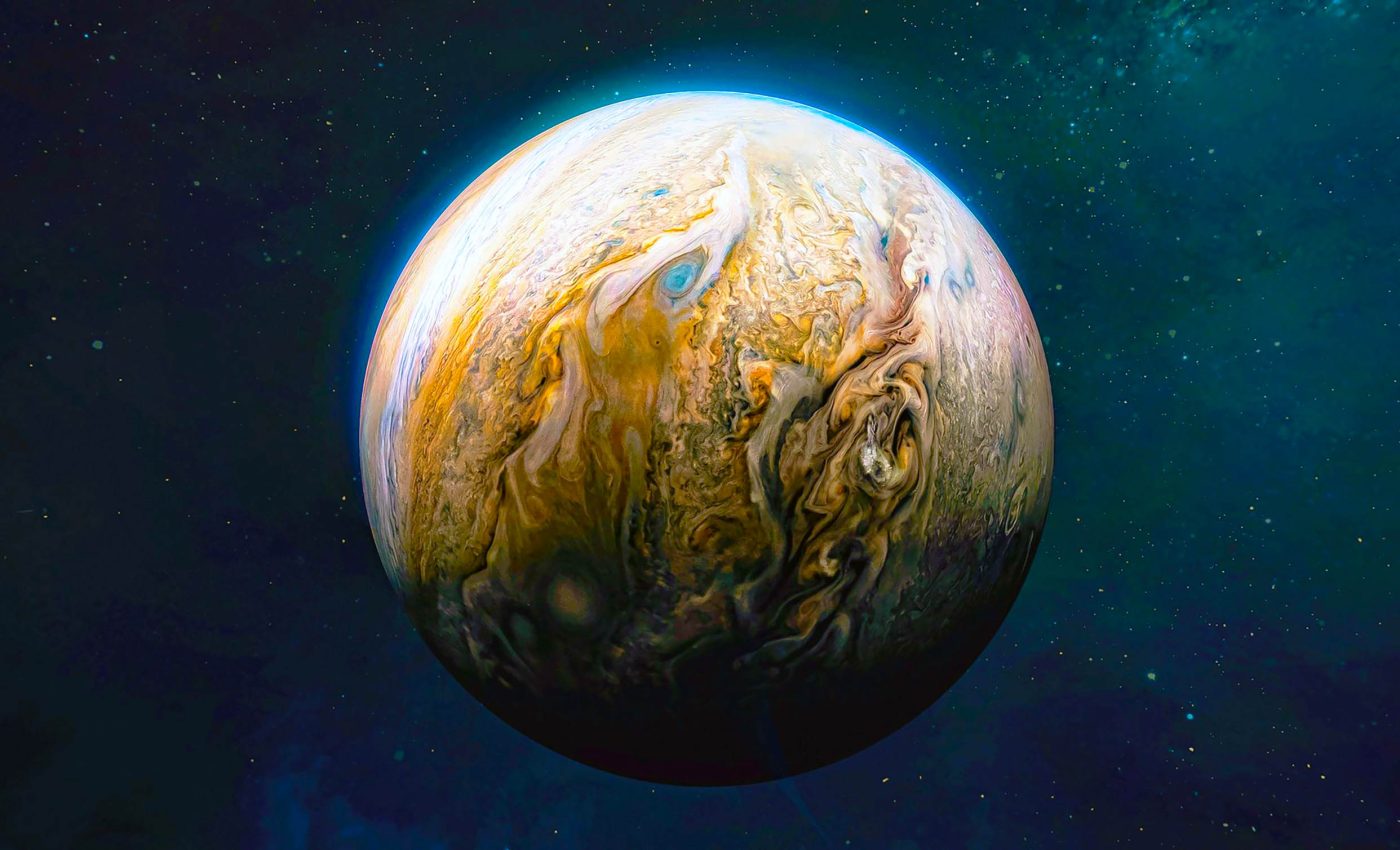
Jupiter’s iconic storms can last for centuries, but what fuels them?
The turbulent storms in Jupiter’s polar regions are driven by processes familiar to physicists studying Earth’s oceans and atmosphere.
This is the conclusion of new research led by Lia Siegelman, a physical oceanographer at UC San Diego’s Scripps Institution of Oceanography.
Siegelman first observed the connection in 2018, noting the similarity between images of Jupiter’s cyclones and the ocean turbulence she studied on Earth.
Since air and water are both fluids, it isn’t so far-fetched to apply ocean physics to Jupiter. “Jupiter is basically an ocean of gas,” explained Siegelman.
Convection helps sustain Jupiter’s storms
This observation led to a 2022 study published in Nature Physics, which analyzed high-resolution infrared images of Jupiter’s cyclones taken by NASA’s Juno spacecraft.
The study revealed that convection, similar to that seen on Earth, helps sustain Jupiter’s massive storms, which can be thousands of miles wide and last for years.
Role of filaments in Jupiter’s storms
The 2022 study focused on Jupiter’s cyclones, but Siegelman also noted the presence of filaments, or wispy tendrils, between the vortices.
These filaments appeared analogous to phenomena on Earth, prompting further investigation using Juno’s detailed imagery to explore whether this similarity was merely superficial.
The current study has uncovered additional similarities between the processes driving Jupiter’s cyclones and those on Earth, revealing that the filaments between Jupiter’s cyclones work in tandem with convection to sustain the planet’s giant storms.
Specifically, these filaments act in ways resembling fronts on Earth, which are boundaries between gas or liquid masses with different densities, often leading to strong vertical velocities that create winds or currents.
Temperatures and wind speeds on Jupiter
To understand the role of the filaments visible in Juno’s images, Siegelman and her co-author, Patrice Klein, analyzed a series of infrared images of Jupiter’s north polar region taken in 30-second intervals.
The infrared images allowed the researchers to determine temperatures, with bright areas indicating warmer regions and dark areas indicating cooler regions.
On Jupiter, warmer areas correspond to thin clouds, while cooler areas represent thick cloud cover, blocking more heat from the planet’s super-heated core.
By tracking the movement of clouds and filaments, the researchers calculated horizontal wind speeds.
Heat from Jupiter’s interior
Combining these measurements with methods from ocean and atmospheric science, Siegelman and Klein calculated the vertical wind speeds that corresponded to the derived temperatures and horizontal wind speeds.
The findings confirmed that Jupiter’s filaments behaved like Earth’s fronts, playing a significant role in transporting energy in the form of heat from Jupiter’s hot interior to its upper atmosphere, thereby fueling the giant cyclones.
While convection is the primary driver, the fronts contribute to a quarter of the total kinetic energy and forty percent of the vertical heat transport powering Jupiter’s cyclones.
Small filaments with a big impact
“These cyclones on Jupiter’s poles have persisted since they were first observed in 2016,” Siegelman said. “These filaments in between the large vortices are relatively small but they are an important mechanism for sustaining the cyclones.”
“It’s fascinating that fronts and convection are present and influential on Earth and Jupiter – it suggests that these processes may also be present on other turbulent fluid bodies in the universe.”
Earth’s mechanisms on far-away planets
Siegelman emphasized that Jupiter’s vast scale and Juno’s high-resolution imagery offer a clearer visualization of how smaller-scale phenomena like fronts connect to larger systems like cyclones and the atmosphere at large.
These connections are often challenging to observe on Earth due to their smaller and more ephemeral nature. However, a new satellite known as SWOT might make observing these ocean phenomena much easier.
“There is some cosmic beauty in finding out that these physical mechanisms on Earth exist on other far-away planets,” Siegelman concluded.
More about Jupiter’s storms
Jupiter is known for its magnificent and turbulent weather systems, including some of the most colossal and enduring storms in the solar system.
Great Red Spot
The most famous of these is the Great Red Spot, a giant storm larger than Earth that has been raging for at least 350 years.
This storm is a high-pressure anticyclone, characterized by swirling clouds of reddish hues, and it stands out against the rest of the planet’s mostly white and ochre atmosphere.
Jupiter’s rapid rotation
The dynamics of Jupiter’s storms are driven by the planet’s rapid rotation, which is the fastest of all the solar system’s planets, completing a rotation roughly every 10 hours.
This rapid rotation contributes to strong jet streams that divide the clouds of the upper atmosphere into dark belts and bright zones.
Storms often form along the boundaries of these belts and zones, where the atmosphere exhibits dramatic shifts in composition and temperature.
Varied appearance and duration
Besides the Great Red Spot, Jupiter is home to many other storms, some appearing as smaller red spots, white ovals, or even brown splotches.
These storms can last for varying lengths of time – some persisting for years and others dissipating much more quickly.
The study is published in the journal Nature Physics.
—–
Like what you read? Subscribe to our newsletter for engaging articles, exclusive content, and the latest updates.
Check us out on EarthSnap, a free app brought to you by Eric Ralls and Earth.com.
—–














